|
On September 22, 1955,
Londoners Sid Allen and George Redlich guided their 6-foot wingspan "Radio Queen"
across the English Channel from the white cliffs of Dover to Calais, France, marking
a first in the model aviation world - a mere 40 minutes in duration. It was approximately
the same path that Louis Bleriot took in 1909 when he became the first to cross
the English Channel in an aeroplane using his homebuilt XI Monoplane. As with many
(maybe most) record-setting model aircraft flights - be they distance or duration
- a diesel engine (ED 0.213 cu. in. Hunter Diesel) was used as the powerplant
due to their reliability (no glow plug or spark plug to burn out or foul) and fuel
economy. Takeoff weight was 7-1/2 pounds, with 1-1/2 pounds of it being accounted
for by three pints of fuel. Guidance was provided by an ED Mk. 4 Miniature, 3-reed
type, from the cockpit of a
Auster Autocrat monoplane.
See all Model Airplanes
News items.
Channel Hop!
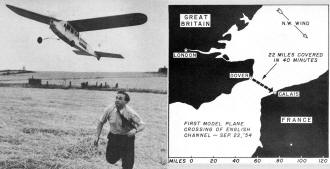
Big moment, as Roger Clark launches 6-foot Radio Queen (with
three pints of fuel aboard) on its historic 22 mile flight across the Channel to
Calais in France.
During the 40 minute Dover-Calais flight, the model attained
3,100 feet after 17 minutes, had to be spun down 1,100 feet. The ceiling was estimated
to be 4,500 feet.
By Bill Dean
The world went wild 45 years ago when Louis Bleriot flew the English Channel.
Now the crossing has been made by model airplane, taking only three more minutes
than did the great French aviator. Here is the story behind that exploit with pictures,
by courtesy of the London Daily Express.
Ever since RC flying got under way in the 'thirties, modelers on both sides of
the English Channel have been dreaming of the day when a model plane would fly along
the same sky trail blazed by Louis Bleriot on his epoch-making hop across the 22-mile
wide strip of water, 45 years ago. The dream at last became reality on Wednesday,
September 22 of this year, when Londoners Sid Allen and George Redlich guided their
6-ft. span Radio Queen across the "ditch" from the white cliffs of Dover to Calais,
France. Total time for the crossing was 40 minutes - just three minutes longer than
Bleriot's own hazardous trip in his flimsy XI Monoplane back in 1909!
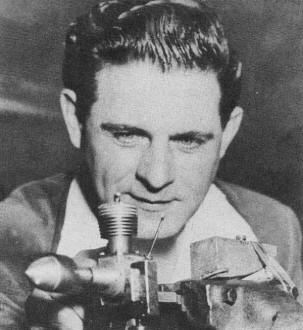
Basil Miles, designer of the .213 Hunter Diesel, checks powerplant
for the Allen-Redlich project on the eve of the cross-channel.
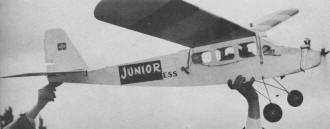
No beauty, the first across-the-channel plane is an ED kit, popular
abroad. The radio is an ED Mk. 4 three-tube type, making an all ED project.
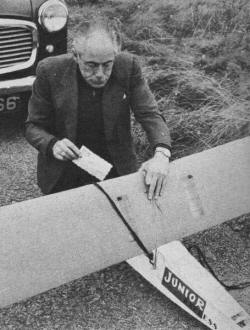
Sid Allen, noted British RC flier, placing air mail letter aboard.
Note the two transparent fuel tanks in wing.
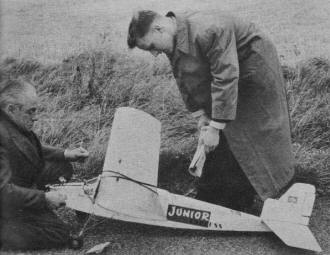
Customs Officer clearing the Radio Queen before its take-off
from the white cliffs of Dover. Numerous long-duration test flights had been made.
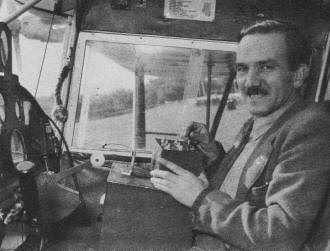
George Redlich, the radio expert, in cockpit of Auster Autocrat,
from which he controlled model. Control was maintained throughout the flight.
Ranking as one of the most important firsts in the history of model aviation,
the flight was especially notable since only standard model equipment, of the type
available in any British or American hobby store, was used. The actual model was
built from a well known kit design by Col. Taplin, which has probably won more
contests than any other RC type, including two firsts at the '54 British Nats. Radio
was an ED Mk. 4 Miniature Three-Reed type and the powerplant was an ED .213 cu.
in. Hunter Diesel.
For several months prior to the crossing, Sid and George logged dozens of long-duration
test flights, checking out various tank schemes, and generally satisfied themselves
that it could be done. Basil Miles, ED's engine designer, personally okayed the
veteran powerplant and found that no special tuning was needed; twin wing-tanks
were fitted (feeding a float-chamber behind Diesel ) and a long downward-pointing
exhaust was fitted to keep the radio compartment under the wing free from waste
fuel.
Over the past few years, several much-heralded "channel attempts" fizzled out
and the newspaper boys have been becoming increasingly bored by the "I'm planning
to fly the Channel" utterences of the beep box characters. However after hearing
all about the carefully laid plans for the Allen-Redlich flight, the Daily Express
- one of the world's two largest newspapers - quickly jumped on the "Bleriot rides
again" band-wagon and from that point there was simply no turning back! Additional
interest developed when it was learned that a rival group headed by Ballard who
hit the headlines in '52 by making the channel crossing with an RC model boat, were
also planning a model plane crossing, escorted in this case by a fast motor launch.
When the big day dawned, everything was just fine from the publicity angle, with
a light plane all ready to follow the model, British Customs Officers giving clearance
and even an air mail letter being sealed in the cabin! The only thing that remained
was the little matter of skipping across the intervening 22 miles of wet stuff that
separates Britain from France - which is not such a straightforward task as it sounds,
since the area is known for its frequent weather changes. Also, even if helpful
off-shore winds usually prevail for the first few miles from Dover, these soon give
way to strong land breezes blowing from the French coast.
At 1 :35 p.m., with George Redlich already circling overhead in a high-wing Auster
Autocrat, Sid Allen pressed the transmitter button for a final control check and
then signaled helper Roger Clark to heave the model skyward. Weight at launching
was 7-1/2 lb. (with 1-1/2 lb. of this being accounted for by three pints of fuel)
and although an unaided take-off had originally been planned, the long grass on
top of the 600-ft. high Dover cliffs made this impractical.
Once airborne, the job climbed steadily, with air control being taken over a
few minutes later by George Redlich (someone else flew the light plane!), who carried
the second transmitter in his lap. Weather conditions at the time included a layer
of high cloud and scattered strata-cumulus with bases at 2,000 ft. Wind at 2,000
ft. was approximately 40 miles an hour from the northwest, with ground visibility
being limited to about nine miles on account of heavy haze.
The 90 hp Cirrus-powered Autocrat was chosen as the escort aircraft since it
could be safely flown in steep turns at 40 mph, plus the important fact that the
generous cabin windows and all-perspex cabin roof provided good all-around visibility.
Pilot Norman Ashe soon realized that it would be all too easy to lose sight of the
model at distances much over 300 yards, so to slow down his ground speed to match
that of the Radio Queen, he had to fly a continuous figure-eight pattern. This naturally
rendered the magnetic compass useless and toppled the Gyro direction indicator,
so from thereon the route had to be flown entirely by visual reference to the indistinct
outlines of the British and French coasts.
It was found best to fly slightly beneath the model as it stood out in sharp
contrast against the sky. Stop watch and altimeter checks showed that the model
climbed to 1,000 ft. above sea level in the first eight minutes after launching
and then from 1,000 ft. to 3,100 in 17 minutes. At this point George decided to
spin it down to the 2,000 ft. level again (no elevators were fitted), where he breathed
a big sigh of relief when the wings didn't fold on the pull-out. Several such dives
were necessary to keep the model from climbing to its estimated 4,500 ft. ceiling,
at which it would have probably overshot the target, on the glide!
Apart from a slight tendency to turn left, which was corrected by right rudder
application at one-minute intervals, the flight was otherwise uneventful until the
French coast was crossed at 2:15 (40 minutes after take-off), with the Hunter still
droning on steadily. Control had been maintained at all times, but after George
brought the model down to 800 ft., he unfortunately lost sight of it and after a
fruitless search was forced finally to put down at Marck Airport, Calais, without
knowing its whereabouts. Happily, the model was soon located in perfect condition
in a field five miles to the southeast of Calais, to the relief of its co-owners,
who were already well into planning their next big flight - that of having a crack
at the long distance record at present held by the USSR!
Posted September 19, 2020
|